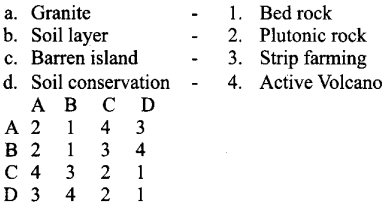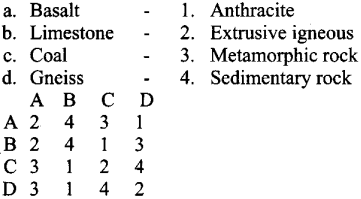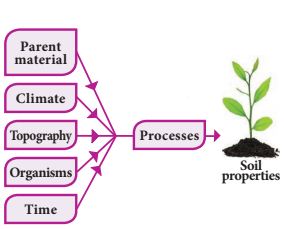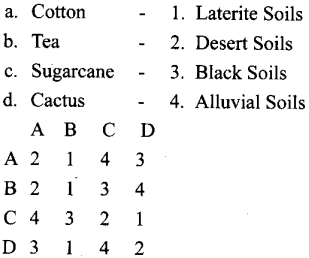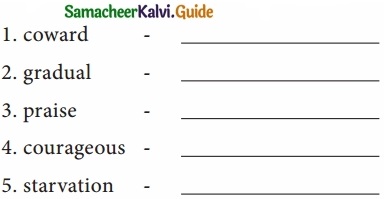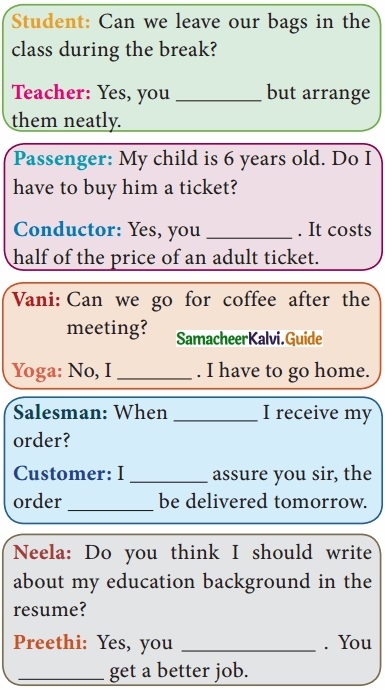Tamilnadu State Board New Syllabus Samacheer Kalvi 8th Social Science Guide Pdf Geography Chapter 2 Weather and Climate Text Book Back Questions and Answers, Important Questions, Notes.
Tamilnadu Samacheer Kalvi 8th Social Science Solutions Geography Chapter 2 Weather and Climate
Samacheer Kalvi 8th Social Science Weather and Climate Text Book Back Questions and Answers
I. Choose the correct answer:
1. Earth’s atmosphere contains about percentage of nitrogen and oxygen.
a) 78% and 21%
b) 22% and 1%
c) 21% and 0.97%
d) 10% and 20%
Answer:
a) 78% and 21%
2. ………………. is generally defined as the average conditions of the weather of a place or a region.
a) earth
b) atmosphere
c) climate
d) sun
Answer
c) climate
3. The earth receives energy from
a) current
b) electro magnetic radiation
c) waves
d) heat
Answer:
d) heat
4. Which one the following represents places with equal amount of rainfall
a) isotherm
b) isohel
c) isobar
d) isohytes
Answer:
d) isohytes
![]()
5. …………. is used to measure the humidity.
a) anemometer
b) barometer
c) hygrometer d) thermometer
Answer:
c) hygrometer
II. Fill in the blank
1. ……………….. refers to the condition of atmosphere for a short period of time.
Answer:
Weather
2. The scientific study of weather is called ………….
Answer:
Meteroiogy
3. The highest temperature ever recorded on the earth is ……………..
Answer:
56.7°C in in USA
4. …………. is a ratio between the actual amount of water vapour and the maximum amount of water vapour the air can hold.
Answer:
Humidity
5. …………. and ………….. are measured by anemometer and wind vane respectively.
Answer:
Wind direction and wind speed
6. ………… are imaginary lines which connect the same temperatures of different places.
Answer:
Isotherms
III. Match the following
| 1. Climate | a) Locating and Tracking Storms |
| 2. Isonif | b) Cyclone |
| 3. Hygrometer | c) Equal Snowfall |
| 4. Radar | d) Long Term Changes |
| 5. Low Pressure | e) Humidity |
Answer:
| 1. Climate | d) Long Term Changes |
| 2. Isonif | c) Equal Snowfall |
| 3. Hygrometer | e) Humidity |
| 4. Radar | a) Locating and Tracking Storms |
| 5. Low Pressure | b) Cyclone |
IV. State whether the following statements are True or False:
1. The atmosphere is a layer of gases surrounding the planet.
Answer:
True
2. The scientific study of weather is called Climatology.
Answer:
False
3. Isohel refers equal sunshine.
Answer:
True
4. Humidity is calculated by Aneroid Barometer.
Answer:
False
V. Answer in brief:
1. Define ‘weather’.
Answer:
Weather is the day today conditions(state) of the atmosphere at any place as regards sunshine, temperature, cloud cover. Wind fog condition, air pressure, humidity, precipitation and such other elements.
2. What is insolation?
Answer:
Incoming solar radiation are called Insolation.
![]()
3. What is meant by atmospheric pressure?
Answer:
The weight of air above a given area on the earth’s surface is called atmospheric pressure or air pressure.
4. Write a short note on “Planetary winds”
Answer:
- Planetary winds are the ones which blow almost in the same direction throughout the year.
- So, they are called as planetary winds.
5. What are “Isolines”?
Answer:
The distribution of weather elements is shown by means of Isolines on maps. Isolines are lines which join the places of equal values of weather elements.
VI. Distinguih the following:
1. Weather and climate.
| Weather | Climate |
| 1. Weather is the day today conditions of the atmosphere like sunshine, temperature humidity and such other elements. | Climate is generally defined as the average conditions of the weather of place or a region. |
| 2. Weather is cool in .winter and hot in summer. | The Climate does not change often like weather. |
2. Absolute and relative humidity.
| Absolute Humidity | Relative Humidity |
| 1. It is the mass or weight of water vapour present per unit volume of air. | It is a ratio between the actual amount of water vapour present in the air and the maximum amount of water vapour it can hold at given temperature. |
| 2. These expressed usually in grams per cubic meter of air. | It is expressed as a percentage. |
3. Permanent and seasonal winds.
| Permanent wind | Seasonal wind |
| 1. Permanent winds, are also called planetary winds. | Monsoon winds are also called as seasonal winds. |
| 2. These winds blow almost in the same direction throughout the year. | These winds are blowing from sea to land during summer and land to sea during winter. |
VII. Give reasons:
1. The Weather and climate in different regions vary.
Answer:
The angle of the sun’s rays, the length of daytime, altitude, distribution of land and water bodies, location and direction of mountain ranges, air pressure, winds, and ocean currents are the major factors which affect the weather and climate of a region.
2. Temperature decreases with an increase in altitude.
Answer:
It is known as the Lapse rate which is 6.5-degree Celcius per 1000 meters is the troposphere.
3. Mountain climbers carry Oxygen cylinders while ascending peaks.
Answer:
With decreasing air pressure, the availability of oxygen to breathe also decreases. At very high altitudes, atmospheric pressure and available oxygen get so low that people can become sick and even die. Mountain climbers use bottled oxygen when they ascend very high peaks.
VIII. Answer in a paragraph:
1. How is temperature measured?
Answer:
Measuring Temperature:
1. The temperature of a unit volume of air at a given time is measured in scales like Celsius, Fahrenheit, and Kelvin. Meteorologist measures the temperature by the Thermometer, Stevenson screen and minimum and maximum Thermometer.
2. The energy received by the earth through insolation is lost by outgoing radiation.
3. Atmosphere is mainly heated by outgoing radiation from 2 to 4 pm. So the maximum temperature is recorded between 2 and 4 pm regularly and the minimum temperature is recorded around 4 am before sunrise.
Mean Temperature:
1. The average of the maximum and minimum temperatures within 24 hours is called mean daily temperature [(87°F + 73°F)/2=80°F].
2. Diurnal range of temperature is the difference between the maximum and minimum temperatures of a day. The annual range of temperature is the difference between the highest and lowest mean monthly temperatures of a year.
2. Write about the wind and its types.
Answer:
The horizontal movement of air is called wind. The wind systems are broadly categorized into three as follows.
- Planetary winds
- Seasonal winds
- Local winds
1. Planetary Winds are the ones which blow almost in the same direction throughout the year. So, they are called as Permanent or planetary winds. Trade winds, Westerlies, and polar easterlies are the types of prevailing winds.
2. Seasonal winds are those which change their direction according to the season in a year. They are called as monsoon winds. These winds blow from sea to land during summer and land to sea during winter.
3. Local winds are the winds that blow over a small area only during a particular time of a day or a short period of a year. Land and sea breezes are examples of these winds.
3. List out the weather elements and associated measuring instruments.
Answer:
| Weather elements | Measuring instruments |
| Temperature | Celsius, Fahrenheit, Kelvin |
| Rainfall | Rain gauge |
| Air Pressure | Aneroid Barometer |
| Humidity | Hygrometer |
| Wind | Anemometer |
IX. Give any three suggestions to reduce global warming:
- Plant trees.
- Recycle the used things.
- Composite wasted food and biodegradables.
Samacheer Kalvi 8th Social Science Weather and Climate Additional Important Questions and Answers
I. Choose the Correct answer:
1. The word Klimo is derived from the language.
a) Greek
b) Latin
c) Arab
d) English
Answer:
a) Greek
2. Horizontal movement of air is called
a) Storm
b) Cyclone
c) Mist
d) Wind
Answer:
d) Wind
![]()
3. The average wind speed is low in
a) France
b) Canada
c) Argentina
d) Brazil
Answer:
d) Brazil
4. The temperature decreases per 1000 meters height is
a) 5°C
b) 6.5°C
c) 7°C
d) 8.5°C
Answer:
b) 6.5°C
5. …………….. is the difference between the maximum and minimum temperatures of a day.
a) Diurnal range
b) Heat conduction
c) Heat radiation
d) Heat elevation
Answer:
a) Diurnal range
6. Which Zone is called a Tropical Zone?
a) Torrid zone
b) Temperate zone
c) Frigid zone
d) Polar zone
Answer:
a) Torrid zone
7. Isobar means
a) Equal Sunshine
b) Equal atmospheric pressure
c) Equal temperature
d) Equal rainfall
Answer:
b) Equal atmospheric pressure
8. The name of an Equal amount of rainfall is
a) Isotherm
b) Isohel
c) Isohyet
d) Isollobar
Answer:
c) Isohyet
9. The name of Equal pressure tendency is
a) Isotherm
b) Isohel
c) Isohyet
d) Isollobar
Answer:
d) Isollobar
10. Major element of weather and climate is
a) Temperature
b) Sound
c) Light
d) Latitude
Answer:
a) Temperature
II. Fill in the blanks:
1. Heat energy from ………………. is received by the earth through three mechanisms.
Answer:
Solar radiation
2. ……………. and soil are the major factors which affect the distribution of temperature.
Answer:
Natural vegetation
![]()
3. The distribution of temperature is shown by means of ………………..
Answer:
Isotherms
4. Temperature zone lies between tropic of …………… circle in the Northern Hemisphere and the ………………. circle in the Southern Hemisphere.
Answer:
Arctic, Antarctic
5. Frigid zone is known as …………………
Answer:
polar region
6. ………………… is a major component of the water cycle.
Answer:
Rain
7. Generally rainfall is high in the …………….. region.
Answer:
Equatorial
8. The average of ……………. and ……………. temperatures within 24 hours is called mean daily temperature.
Answer:
maximum, minimum
9. …………………. is a diagram used to depict the direction and periods of prevailing winds on a map.
Answer:
Wind rose
10. Weather is the day to day conditions of the ………………………..
Answer:
atmosphere
11. The amount of carbon dioxide in the atmosphere is ………………..
Answer:
0.03%
12. The amount of argon in the atmosphere is …………….
Answer:
0.97%
13. The word Klimo means ……………….
Answer:
Inclination
14. Climate is the average atmospheric conditions usually for ………………..
Answer:
35 years
15. The Scientific Study of Climate is called …………….
Answer:
Climatology
III. Match the following:
| 1. Aniroid | a) Temperature |
| 2. Beaufort | b) diagram |
| 3. Wind rose | c) Wind speed |
| 4. Fahrenheit | d) humidity |
| 5. Hydrometer | e) air pressure |
Answer:
| 1. Aniroid | e) air pressure |
| 2. Beaufort | c) Wind speed |
| 3. Wind rose | b) diagram |
| 4. Fahrenheit | a) Temperature |
| 5. Hydrometer | d) humidity |
IV. State whether the following statements are True or False:
1. The highest temperature ever recorded on the earth is 56.7°C.
Answer:
True
2. The degree of heat present in the sun is termed as temperature.
Answer:
False
![]()
3. Rainfall is measured by Raingauge.
Answer:
True
4. Temperature decreases to 8°C per 1000 meters in height.
Answer:
False
5. Al-Balakhi prepared the first climatic Atlas of the world.
Answer:
True
V. Answer in brief:
1. What are the Controlling factors of weather and climate?
Answer:
The angle of the sun’s rays, the length of daytime, altitude, distribution of land and water bodies, location and direction of mountain ranges, air pressure, winds, and ocean currents are the major factors which affect the weather and climate of a region.
2. What are the factors affecting the distribution of temperature?
Answer:
Latitude, altitude, nature of the land, ocean currents, prevailing winds, slope, shelter, and distance from the sea, natural vegetation, and soil are the major factors which affect the distribution of temperature.
3. What are the Isotherms?
Answer:
- The distribution of temperature is shown by means of Isotherms.
- Isotherms are imaginary lines which connect the same temperatures of different places..
VI. Distinguish the following:
1. Torrid zone and Temperature zone.
|
Torrid zone |
Temperature zone |
| 1. It is a region between the tropic of cancer and the tropic of Capricorn. | This zone lies between the Tropic of cancer and the Arctic circle in the Northern Hemisphere and between the Tropic of Capricorn and the Antarctic circle in the Southern Hemisphere. |
| 2. This region receives the direct rays of the sun and gets the maximum heat from the sun. | This zone gets the slanting rays of the sun |
| 3. This zone is known as the tropical zone. | The angle of the sun’s rays goes on decreasing towards the poles. |
2. Specific humidity and Relative humidity.
|
Specific humidity |
Relative humidity |
| 1. Specific humidity is a ratio of the water vapor content of the mixture to the total air content on a mass basis. | The relative humidity is a ratio between the actual amount of water vapour present in the air and the maximum amount of water vapour. |
| 2. It is expressed in grams of vapour per kilogram of air. | It is expressed as a percentage. |
VII. Give reasons:
1. Why artificial pressure creates in Aircraft?
Answer:
- At very high altitudes, atmospheric pressure and available oxygen get so low as the quick move from high pressure to low pressure can cause decompression sickness.
- Aircraft create artificial pressure in the cabin which makes the passengers remain comfortable while flying.
VIII. Answer in a paragraph:
1. Define the types of humidity.
Answer:
The types of humidity are
- Specific humidity
- Absolute humidity
- Relative humidity
Specific humidity:
Specific humidity is a ratio of the water vapor content of the mixture to the total air content on a mass basis. It is expressed in grams of vapour per kilogram of air.
Absolute humidity:
Absolute Humidity is the mass or weight of water vapour present per unit volume of air.
Relative humidity:
It is a ratio between the actual amount of water vapour present in the air and the maximum amount of water vapour it can hold at a given temperature.
